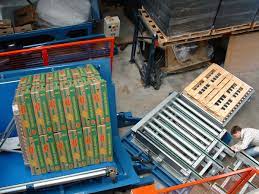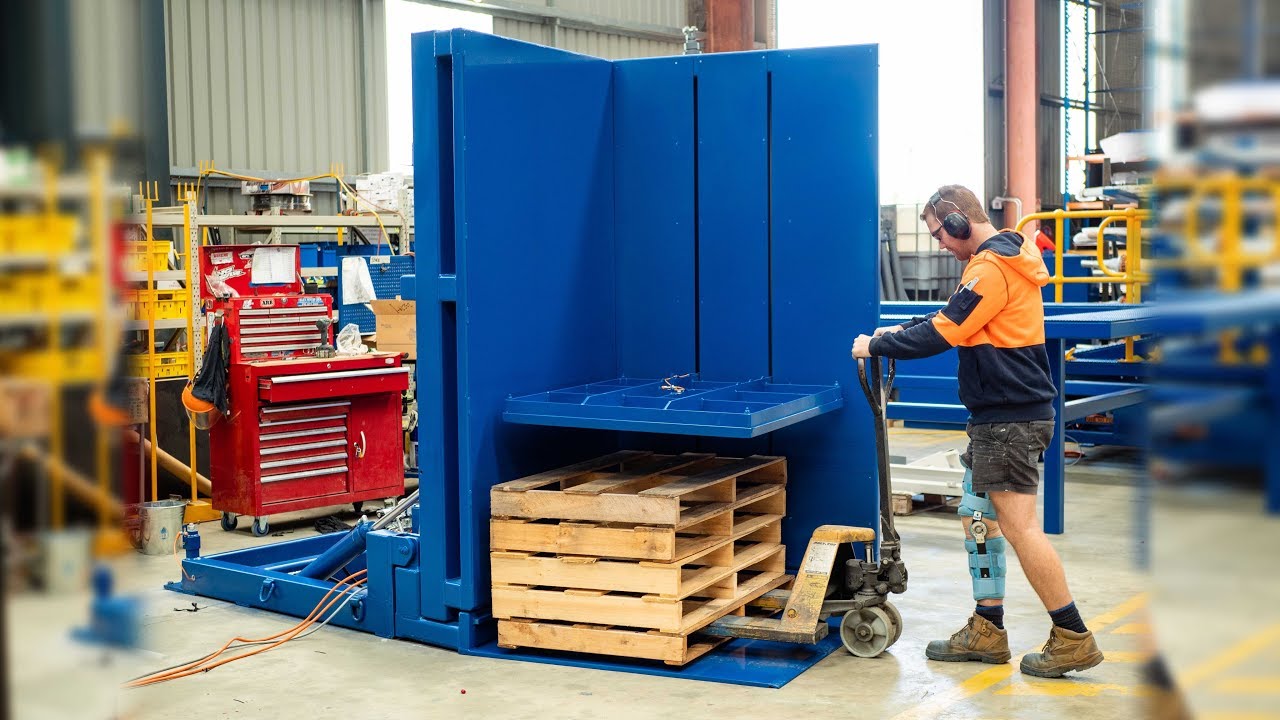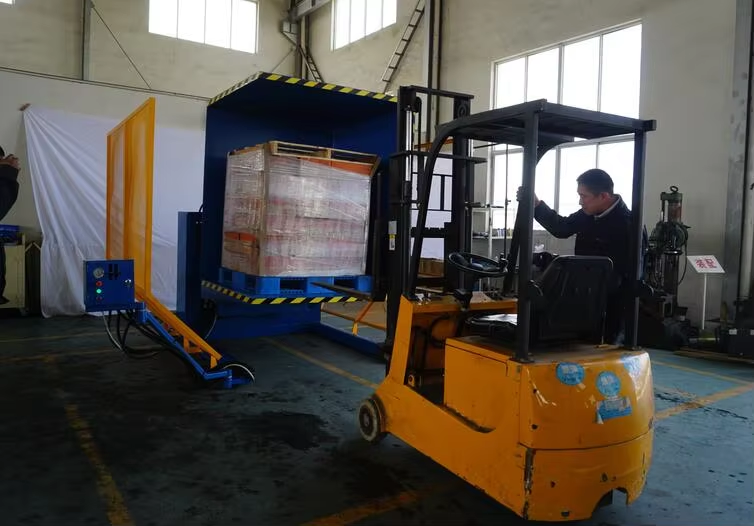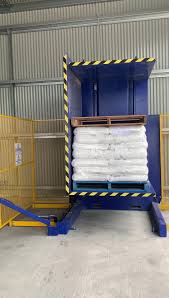Pallet Inverter: How to Rotate Lumber Pallets Without Splintering?
Handling heavy stacks of lumber presents a tough challenge. You need to move, store, and ship them, but the process is full of risks. Manually turning or swapping pallets is slow, physically demanding for your team, and often leads to splintered, damaged wood. Every piece of damaged lumber is a direct hit to your profits. This manual inefficiency can create bottlenecks in your entire operation, slowing down shipments and increasing the risk of workplace injuries. There has to be a better way to manage this critical task, one that protects both your product and your people.
A pallet inverter is the definitive solution for rotating lumber pallets without causing splinters or damage. The machine operates by securely clamping the entire load of lumber from both the top and bottom using adjustable pressure. Once secured, it smoothly rotates the entire stack 180 degrees. This allows for the safe and quick exchange of the bottom pallet without any manual handling of the individual lumber pieces, which preserves the wood's quality and integrity.

This simple-sounding process has huge implications for any business dealing with lumber or other sensitive materials. It’s not just about turning a load upside down. It's about taking a chaotic, risky, and wasteful manual task and transforming it into a controlled, safe, and efficient automated process. Now that you know the core function, let's look closer at the mechanics that make it work, the direct benefits to your operational efficiency, and how this technology aligns with the long-term strategic goals of a modern business owner like yourself.
What is the Mechanism that Prevents Lumber Damage During Rotation?
You might be worried that a powerful machine could be too rough on your lumber. We’ve all seen automation that ends up crushing or scraping products, turning a potential solution into another source of waste. The last thing you need is to invest in new equipment only to find it damages your valuable inventory, completely defeating the purpose of improving quality and reducing costs.
The mechanism that prevents lumber damage is the pallet inverter's advanced dual-clamping system, which operates with precisely adjustable hydraulic pressure. This system is designed to apply the minimum force necessary to securely hold the load, preventing any crushing or deformation of the wood. Furthermore, the large clamping plates are typically lined with soft, durable materials like rubber or polyurethane. These surfaces provide a firm but gentle grip, protecting the lumber from splinters, scratches, and marks as it undergoes the 180-degree rotation.

A Deeper Look at the Clamping Technology
The genius of the pallet inverter is not in its power, but in its control. For a business leader like Javier Morales, who understands the fine details of machinery and production, this control is everything. It’s the difference between a blunt instrument and a precision tool.
-
Adjustable Hydraulic Pressure: The heart of the system is a hydraulic power pack that allows the operator or an automated system to set the clamping pressure. This is critical. A stack of green, heavy hardwood requires different pressure than a stack of dried, lightweight pine. This adjustability ensures that every load, regardless of weight, density, or stack height, is held securely but gently. This feature directly addresses the challenge of handling various products within a large-scale operation and protects the quality of the final output.
-
Soft-Contact Surfaces: Raw steel clamps would be a disaster for finished lumber. That's why the contact plates are so important. They create a protective barrier between the machine and the product. Let's compare the options:
| Clamping Plate Material | Pros | Cons | Best For |
|---|---|---|---|
| Steel with Rubber Lining | Excellent grip, good protection, cost-effective | Rubber can wear over time and need replacement | General-purpose lumber, finished wood products |
| Polyurethane Lining | Extremely durable, non-marking, superior protection | Higher initial cost | High-value lumber, painted or treated surfaces, high-volume operations |
| Solid Steel (Unlined) | Maximum durability, low maintenance | High risk of damaging product, not recommended for wood | Non-sensitive loads like metal ingots or concrete blocks |
As a founder who built my own factory, I learned early on that preventing waste is more profitable than simply increasing production speed. By investing in a machine with the right clamping technology, you are essentially buying insurance against product damage. For a steel mill owner like Javier, who scrutinizes every investment for its ROI, preventing the loss of even a small percentage of a 2-million-ton annual output represents a significant financial gain. This mechanism isn't just a feature; it's a core component of your quality control and cost-reduction strategy.
How Does a Pallet Inverter Improve Operational Safety and Efficiency?
Are slow manual processes and the constant risk of workplace accidents holding back your plant's true potential? You know better than anyone that every minute of operational downtime and every safety incident report is a direct drain on your bottom line. The physical toll of manually handling tons of lumber day after day leads to injuries, claims, and a workforce that is tired and less productive.
A pallet inverter transforms this high-risk, time-consuming task into a streamlined, automated process. It drastically improves operational safety by removing the need for manual lifting and restacking, which is a leading cause of musculoskeletal injuries in industrial settings. At the same time, it boosts efficiency by performing a complete pallet exchange cycle in less than a minute. This is a task that would take several workers 15 to 20 minutes to do by hand, allowing you to increase throughput and better allocate your labor resources.

Breaking Down the ROI on Safety and Speed
For a pragmatic leader like Javier, improvements must be quantifiable. Vague promises of "better workflow" are not enough. The investment must show a clear path to achieving goals like increasing capacity utilization to 95% and reducing overall operational costs.
The Safety Dividend
Safety is not just a regulatory requirement; it's a cornerstone of an efficient operation. A safe workplace has higher morale, lower employee turnover, and fewer interruptions.
- Ergonomics: Manual pallet swapping involves repeated bending, lifting, and twisting with heavy, awkward loads—a recipe for back, shoulder, and knee injuries. An inverter operator, by contrast, stands at a control panel, often in an ergonomic position, simply pushing buttons.
- Reduced Costs: A single serious back injury can result in tens of thousands of dollars in medical bills, lost work time, and insurance premium hikes. Preventing just one such incident can often justify a significant portion of the inverter's cost. This directly impacts the bottom line by lowering hidden operational expenses.
The Efficiency Engine
This is where the impact on productivity becomes undeniable. Let's compare the two methods directly:
| Metric | Manual Pallet Swap | Pallet Inverter Operation | Impact on Goals |
|---|---|---|---|
| Time per Pallet | 15-20 minutes | ~60 seconds | Drastically increases throughput, helping achieve 95% capacity utilization. |
| Labor Required | 2 workers | 1 operator | Reduces direct labor cost per pallet; frees up 1 worker for value-added tasks. |
| Product Damage Risk | High (splintering, dropping, shifting) | Extremely Low (controlled, secure process) | Increases yield, reduces waste, contributes to 8%+ cost reduction goal. |
| Consistency | Varies by worker and fatigue level | Perfectly consistent every cycle | Creates a predictable, stable production flow. |
I remember visiting a client's facility, much like Javier's, where their loading dock was a constant bottleneck. After we installed a pallet inverter, they not only eliminated the logjam but also reported a 70% reduction in back-related safety incidents in that area within six months. The machine paid for itself in under a year on labor savings and injury prevention alone. This is how you turn a cost center into a high-efficiency part of your production line.
What are the Different Types of Pallet Inverters for a Steel Mill's Needs?
When you're considering a significant equipment purchase, the number of options can feel overwhelming. Choosing the wrong type of machine for your plant's specific layout, material flow, and volume can be a very expensive mistake. A stationary machine might be useless if you need mobility, while a forklift-loaded model could become a new bottleneck if you really need full automation. Making the wrong choice means you are stuck with a piece of equipment that doesn't solve your core problem and fails to deliver the expected ROI.
For a high-capacity operation like a steel mill that handles heavy loads like lumber, the most relevant types of pallet inverters are the Free-standing 180° Rotator and the In-line Pallet Changer. The free-standing model is loaded with a forklift and offers great placement flexibility. The in-line model, on the other hand, is designed to integrate directly into an automated conveyor system for maximum, hands-off throughput.

Matching the Machine to the Mission
As an engineer who has designed and installed these systems for years, I always tell my clients that the right machine is the one that fits seamlessly into their existing—and future—operational vision. For a forward-thinking owner like Javier, this means considering not just today's needs but also the goals of digitalization and increased automation.
Type 1: The Free-standing, Forklift-Loaded Inverter
This is the workhorse of pallet inverters. A forklift places the entire palletized load into the machine's opening. The operator initiates the cycle, the load is clamped and rotated, and the forklift returns to remove the inverted load and the old pallet.
- Best Suited For: Operations that need flexibility. You can place this machine wherever you have floor space and forklift access—at the receiving dock, in a quality control area, or near the shipping bay. It's an excellent choice for handling varied workflows or as a first step into automation because it doesn't require a massive overhaul of your plant layout. It provides an immediate solution to the manual handling problem with a lower initial capital investment.
Type 2: The In-line, Conveyor-Fed Pallet Changer
This is the ultimate solution for efficiency and automation. This machine becomes a fully integrated node in your production line. Pallet loads arrive on a conveyor, are automatically fed into the changer, inverted, and then sent down the line on their new pallet without a forklift or operator ever touching them.
- Best Suited For: High-volume, standardized production lines. This aligns perfectly with Javier's goals of pushing digital transformation and achieving 95% capacity utilization. An in-line system can be connected to the plant's MES (Manufacturing Execution System), providing real-time data on cycle times and throughput. It runs continuously, maximizing efficiency and minimizing labor. While the initial investment is higher, the long-term ROI in a 2-million-ton-per-year facility is immense.
| Feature | Free-standing Inverter | In-line Pallet Changer | Strategic Fit for Javier |
|---|---|---|---|
| Throughput | Medium (15-25 pallets/hour) | High (40-60+ pallets/hour) | In-line model directly supports the goal of increasing capacity utilization. |
| Labor Requirement | 1 Forklift Operator | Fully Automatic (Supervisory) | In-line model maximizes labor cost reduction and supports a leaner operation. |
| Footprint | Flexible, but requires forklift area | Fixed, requires line integration | The decision depends on the specific area's layout and strategic importance. |
| Digital Integration | Limited (stand-alone) | High (MES/SCADA connectivity) | In-line model is essential for achieving the goal of comprehensive production visualization and digital transformation. |
| Initial Cost | Lower | Higher | The choice depends on a detailed ROI analysis, balancing initial outlay against long-term operational savings. |
The choice is not just about a machine; it’s a strategic decision. Do you need a flexible solution for a specific problem area (Free-standing), or are you ready to invest in top-tier automation to optimize a core production line (In-line)?
How Does Investing in a Pallet Inverter Align with Long-Term Profitability and Sustainability Goals?
As a CEO, you are constantly balancing immediate operational needs with the long-term vision for your company. You're not just looking at this quarter's performance; you're building a sustainable and profitable enterprise for the next decade. There's a valid concern that a new equipment purchase might solve one problem but work against your bigger strategic goals for profitability, digitalization, and environmental responsibility.
An investment in a modern pallet inverter is not just a tactical purchase; it is a strategic asset that directly contributes to your most important long-term goals. It drives profitability by cutting costs and waste, supports sustainability goals by reducing energy and material consumption, and serves as a key component in your digital transformation journey.

A Strategic Asset for the Modern Industrial Leader
For an entrepreneur like Javier, who has successfully navigated the cycles of the steel industry, every investment must be future-proof. It must address today's challenges while paving the way for tomorrow's opportunities. A pallet inverter does exactly that.
Driving Profitability (Goal: Reduce operating costs by 8%+)
Profitability is enhanced through a multi-pronged attack on inefficiency and waste.
- Reduced Product Waste: As discussed, preventing splintered lumber directly increases your saleable yield. Less damaged product means more revenue from the same amount of raw material.
- Lower Labor Costs: Automating the pallet swap function reduces the man-hours required per ton of product shipped. This lowers direct labor costs and protects against rising wages.
- Elimination of Injury Costs: Preventing safety incidents avoids the significant direct and indirect costs associated with worker compensation and downtime.
- Increased Throughput: A faster process means more product can be moved through the facility in the same amount of time, increasing revenue potential without adding shifts.
Enhancing Sustainability (Goals: Lower energy consumption, meet environmental standards)
Sustainability is no longer a buzzword; it's a business imperative.
- Energy Efficiency: A modern, efficient hydraulic power pack on an inverter consumes far less energy to rotate a load than a large forklift does maneuvering back and forth for 15 minutes, burning diesel or draining its battery. It's a more energy-efficient solution for the specific task.
- Material Waste Reduction: This is a huge, often overlooked benefit. A pallet inverter allows you to use high-quality, durable pallets within your facility and then swap them for cheaper, one-way shipping pallets right before dispatch. This drastically reduces your spending on expensive pallets that never return. It also allows you to easily remove and recycle a single broken pallet from a stack before it fails and causes a major spill.
Enabling Digital Transformation (Goal: Deploy MES, IoT)
The pallet inverter, especially the in-line model, is an Industry 4.0-ready machine.
- Data Integration: It can be equipped with sensors and controllers that communicate directly with your plant's Manufacturing Execution System (MES). This provides management with real-time data on throughput, cycle counts, and operational status, contributing directly to the goal of "comprehensive production visualization." You can track the performance of your packaging line as easily as you track the output of your furnace.
From my experience helping hundreds of clients, the most successful ones are those who see equipment not as a cost, but as an enabler of their strategic vision. A pallet inverter is a perfect example of such an investment.
My Insights
I remember meeting with a client, let's call him Carlos, who ran a large wood processing plant in South America. He had the same challenges Javier faces: rising labor costs, frustrating product damage during handling, and pressure to modernize. When I first brought up the idea of a pallet inverter, he was skeptical. He saw it as just another piece of heavy equipment, another expense on a long list.
I didn't try to sell him a machine. Instead, we walked through his plant together. We stood by the shipping area and used a stopwatch to time his team as they manually unloaded a pallet of finished lumber onto a shipping pallet. It took two men nearly 20 minutes, and by the end, a few boards were scuffed. We looked at the small but persistent pile of splintered, rejected lumber in the corner—a pile that represented pure, lost profit. We talked about a recent back injury that had sidelined one of his best workers for weeks, costing him dearly in both productivity and morale.
I didn't give him a sales pitch. I just asked him a simple question: "Carlos, what if you could turn that 20-minute, two-person job into a 60-second, one-person task? What if that pile of wasted product in the corner never grew any bigger?"
The question changed his perspective. He stopped seeing a machine and started seeing a solution. We installed a single free-standing unit as a trial. Three months later, he called me to order two more for his other production lines. When I visited again, he told me something that has stuck with me ever since. He said, "Vincent, it wasn't just about the money I saved on wages or damaged wood, though that was significant. You gave me control over a part of my process I thought was uncontrollable."
For a business owner like Javier or Carlos, who is responsible for the entire operation, that sense of control, predictability, and stability is priceless. That is the real value a pallet inverter brings to your factory floor. It turns a chaotic, risky, and unpredictable task into a smooth, reliable, and profitable part of your operation.
Conclusion
A pallet inverter is a vital strategic investment. It directly solves the problem of rotating lumber without damage, while simultaneously boosting safety, efficiency, and supporting your long-term profitability and sustainability goals.





